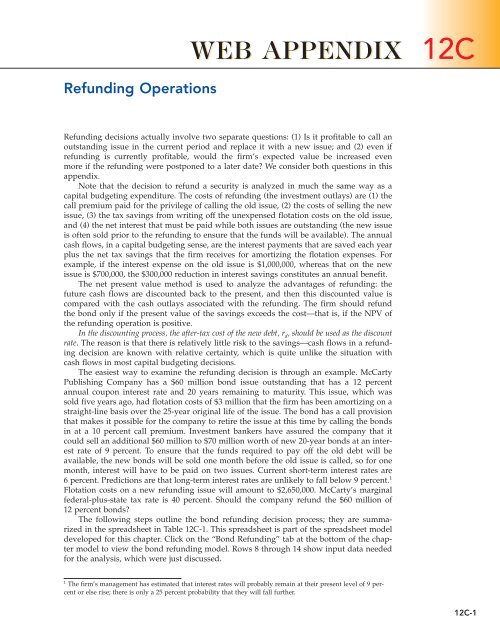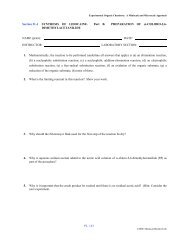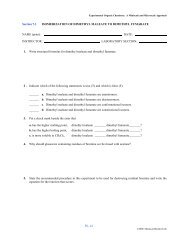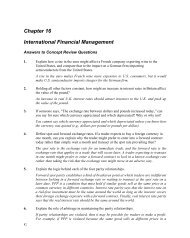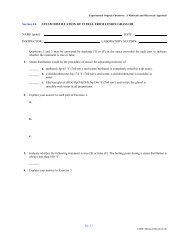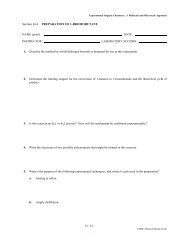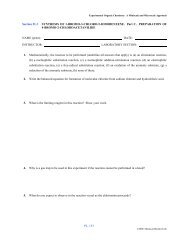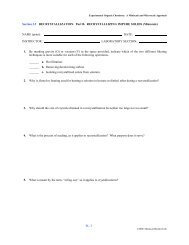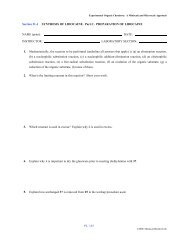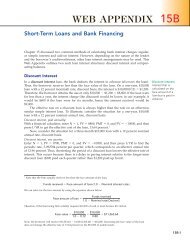WEB APPENDIX 12C
WEB APPENDIX 12C
WEB APPENDIX 12C
You also want an ePaper? Increase the reach of your titles
YUMPU automatically turns print PDFs into web optimized ePapers that Google loves.
Refunding Operations<strong>WEB</strong> <strong>APPENDIX</strong> <strong>12C</strong>Refunding decisions actually involve two separate questions: (1) Is it profitable to call anoutstanding issue in the current period and replace it with a new issue; and (2) even ifrefunding is currently profitable, would the firm’s expected value be increased evenmore if the refunding were postponed to a later date? We consider both questions in thisappendix.Note that the decision to refund a security is analyzed in much the same way as acapital budgeting expenditure. The costs of refunding (the investment outlays) are (1) thecall premium paid for the privilege of calling the old issue, (2) the costs of selling the newissue, (3) the tax savings from writing off the unexpensed flotation costs on the old issue,and (4) the net interest that must be paid while both issues are outstanding (the new issueis often sold prior to the refunding to ensure that the funds will be available). The annualcash flows, in a capital budgeting sense, are the interest payments that are saved each yearplus the net tax savings that the firm receives for amortizing the flotation expenses. Forexample, if the interest expense on the old issue is $1,000,000, whereas that on the newissue is $700,000, the $300,000 reduction in interest savings constitutes an annual benefit.The net present value method is used to analyze the advantages of refunding: thefuture cash flows are discounted back to the present, and then this discounted value iscompared with the cash outlays associated with the refunding. The firm should refundthe bond only if the present value of the savings exceeds the cost—that is, if the NPV ofthe refunding operation is positive.In the discounting process, the after-tax cost of the new debt, r d , should be used as the discountrate. The reason is that there is relatively little risk to the savings—cash flows in a refundingdecision are known with relative certainty, which is quite unlike the situation withcash flows in most capital budgeting decisions.The easiest way to examine the refunding decision is through an example. McCartyPublishing Company has a $60 million bond issue outstanding that has a 12 percentannual coupon interest rate and 20 years remaining to maturity. This issue, which wassold five years ago, had flotation costs of $3 million that the firm has been amortizing on astraight-line basis over the 25-year original life of the issue. The bond has a call provisionthat makes it possible for the company to retire the issue at this time by calling the bondsin at a 10 percent call premium. Investment bankers have assured the company that itcould sell an additional $60 million to $70 million worth of new 20-year bonds at an interestrate of 9 percent. To ensure that the funds required to pay off the old debt will beavailable, the new bonds will be sold one month before the old issue is called, so for onemonth, interest will have to be paid on two issues. Current short-term interest rates are6 percent. Predictions are that long-term interest rates are unlikely to fall below 9 percent. 1Flotation costs on a new refunding issue will amount to $2,650,000. McCarty’s marginalfederal-plus-state tax rate is 40 percent. Should the company refund the $60 million of12 percent bonds?The following steps outline the bond refunding decision process; they are summarizedin the spreadsheet in Table <strong>12C</strong>-1. This spreadsheet is part of the spreadsheet modeldeveloped for this chapter. Click on the “Bond Refunding” tab at the bottom of the chaptermodel to view the bond refunding model. Rows 8 through 14 show input data neededfor the analysis, which were just discussed.1The firm’s management has estimated that interest rates will probably remain at their present level of 9 percentor else rise; there is only a 25 percent probability that they will fall further.<strong>12C</strong>-1
<strong>12C</strong>-2 Web Appendix <strong>12C</strong> Refunding OperationsTABLE <strong>12C</strong>-1Spreadsheet for the Bond Refunding DecisionStep 1: Determine the Investment Outlay Requiredto Refund the IssueRow 19.Call premium on old issue:Before tax: 0.10($60,000,000) $6,000,000After tax: $6,000,000(1 T) $6,000,000(0.6) $3,600,000Although McCarty must spend $6 million on the call premium, this is a deductibleexpense in the year the call is made. Because the company is in the 40 percent tax bracket,it saves $2.4 million in taxes; therefore, the after-tax cost of the call is only $3.6 million.
Web Appendix <strong>12C</strong> Refunding Operations<strong>12C</strong>-3Row 20. Flotation costs on new issue:Flotation costs on the new issue will be $2,650,000. This amount cannot be expensed fortax purposes, so it provides no immediate tax benefit.Row 21. Flotation costs on old issue:The old issue has an unamortized flotation cost of (20/25)($3,000,000) $2,400,000 at thistime. If the issue is retired, the unamortized flotation cost may be recognized immediatelyas an expense, thus creating an after-tax savings of $2,400,000(T) $960,000. Because thisis a cash inflow, it is shown as a positive number.Rows 22 and 23. Additional interest:One month’s “extra” interest on the old issue, after taxes, costs $360,000:(Dollar amount)(1/12 of 12%)(1 T) Interest cost($60,000,000)(0.01)(0.6) $360,000However, the proceeds from the new issue can be invested in short-term securities for onemonth. Thus, $60 million invested at a rate of 6 percent will return $180,000 in after-taxinterest:($60,000,000)(0.06/12)(1 T) Interest earned($60,000,000)(0.005)(0.6) $180,000The net after-tax additional interest cost is thus $180,000:Interest paid on old issue ($360,000)Interest earned on short-term securities 180,000Net additional interest ($180,000)Row 24. Total after-tax investment:The total investment outlay required to refund the bond issue, which will be financed bydebt, is thus $5,470,000: 2Call premium ($3,600,000)Flotation costs, new (2,650,000)Flotation costs, old, tax savings 960,000Net additional interest (180,000)Total investment ($5,470,000)Step 2: Calculate the Annual Flotation Cost Tax EffectsRow 27. Tax savings on flotation costs on the new issue:For tax purposes, flotation costs must be amortized over the life of the new bond, or for20 years. Therefore, the annual tax deduction is$2,650,00020 $132,500The spreadsheet shows dollars in thousands, so this number appears as 133 on thespreadsheet. Because McCarty is in the 40 percent tax bracket, it has a tax savings of$132,500(0.4) $53,000 a year for 20 years. This is an annuity of $53,000 for 20 years.2 The investment outlay (in this case, $5,470,000) is usually obtained by increasing the amount of the new bondissue. In the example given, the new issue would be $65,470,000. However, the interest on the additional debtshould not be deducted at Step 3 because the $5,470,000 itself will be deducted at Step 4. If additional intereston the $5,470,000 were deducted at Step 3, interest would, in effect, be deducted twice. The situation here isexactly like that in regular capital budgeting decisions. Even though some debt may be used to finance aproject, interest on that debt is not subtracted when developing the annual cash flows. Rather, the annual cashflows are discounted at the project’s cost of capital.
<strong>12C</strong>-4 Web Appendix <strong>12C</strong> Refunding OperationsRow 28. Tax benefits lost on flotation costs on the old issue:The firm, however, will no longer receive a tax deduction of $120,000 a year for 20 years,so it loses an after-tax benefit of $48,000 a year.Row 29. Net amortization tax effect:The after-tax difference between the amortization tax effects of flotation on the new andold issues is $5,000 a year for 20 years.Step 3: Calculate the Annual Interest SavingsRow 32. Interest on old bond, after tax:The annual after-tax interest on the old issue is $4.32 million:($60,000,000)(0.12)(0.6) $4,320,000Row 40. Interest on new bond, after tax:The new issue has an annual after-tax cost of $3,240,000:($60,000,000)(0.09)(0.6) $3,240,000Row 41. Net annual interest savings:Thus, the net annual interest savings is $1,080,000:Interest on old bonds, after tax $4,320,000Interest on new bonds, after tax (3,240,000)Annual interest savings, after tax $1,080,000Step 4: Determine the NPV of the RefundingRow 45. PV of the benefits:The PV of the annual after-tax flotation cost benefit of $5,000 a year for 20 years is $60,251,and the PV of the $1,080,000 annual after-tax interest savings for 20 years is $13,014,216. 3We can also solve for the present value of the benefits by using a financial calculator.To determine the present value of the after-tax flotation cost benefit, enter into your calculatorthe following data: N 20; I/YR 5.4; PMT 5000; FV 0. Then, solve for PV $60,250.80 $60,251.To determine the present value of the after-tax interest savings, enter into your calculatorthe following data: N 20; I/YR 5.4; PMT 1080000; FV 0. Then, solve forPV $13,014,173.78 $13,014,174.These values are used to find the NPV of the refunding operation:Amortization tax effects $ 60,251Interest savings 13,014,174Net investment outlay (5,470,000)NPV from refunding $ 7,604,425Because the net present value of the refunding is positive, it will be profitable to refundthe old bond issue.We can summarize the data shown in Table <strong>12C</strong>-1 using a time line (amounts in thousands)as shown below:Time period 0 5.4%1220After-tax investmentFlotation cost tax effectsInterest savingsNet cash flows5,4705,47051,0801,08551,0801,08551,0801,0853 Note that the spreadsheet uses Excel’s PV function to solve for the present values of the annual flotation costand interest savings.
Web Appendix <strong>12C</strong> Refunding Operations<strong>12C</strong>-5NPV 5.4% $7,604.Several other points should be made. First, because the cash flows are based on differencesbetween contractual obligations, their risk is the same as that of the underlying obligations.Therefore, the present values of the cash flows should be found by discounting atthe firm’s least risky rate—its after-tax cost of marginal debt. Second, the refunding operationis advantageous to the firm, thus it must be disadvantageous to bondholders; theymust give up their 12 percent bonds and reinvest in new ones yielding 9 percent. Thispoints out the danger of the call provision to bondholders, and it also explains why bondswithout a call feature command higher prices than callable bonds. Third, although it isnot emphasized in the example, we assumed that the firm raises the investment requiredto undertake the refunding operation (the $5,470,000 shown on Row 24 of Table <strong>12C</strong>-1) asdebt. This should be feasible because the refunding operation will improve the interestcoverage ratio, even though a larger amount of debt is outstanding. 4 Fourth, we set upour example in such a way that the new issue had the same maturity as the remaining lifeof the old one. Often, the old bonds have a relatively short time to maturity (say, 5 to 10years), whereas the new bonds have a much longer maturity (say, 25 to 30 years). In sucha situation, the analysis should be set up similarly to a replacement chain analysis in capitalbudgeting, which is discussed in Fundamentals of Financial Management, 11th edition,Chapter 13, or in Concise Fundamentals, 5th edition, Web Appendix 12F. Fifth, refundingdecisions are well suited for analysis with a computer spreadsheet program. Spreadsheetssuch as the one shown in Table <strong>12C</strong>-1 are easy to set up, and once the model has beenconstructed, it is easy to vary the assumptions (especially the assumption about the interestrate on the refunding issue), and to see how such changes affect the NPV.One final point should be addressed: Although our analysis shows that the refundingwould increase the firm’s value, would refunding at this time truly maximize the firm’sexpected value? If interest rates continue to fall, the company might be better off waiting,for this could increase the NPV of the refunding operation even more. The mechanics ofcalculating the NPV in a refunding are easy, but the decision of when to refund is not simpleat all because it requires a forecast of future interest rates. Thus, the final decision onrefunding now versus waiting for a possibly more favorable time is a judgmental decision.QUESTIONS<strong>12C</strong>-1 How does refunding analysis compare to standard capital budgeting analysis?<strong>12C</strong>-2 What is the appropriate discount rate to use in refunding analysis? Why?<strong>12C</strong>-3 If a refunding analysis shows that a refund would have a positive NPV, should the firmalways proceed with the bond refund? Explain.4 See Ahron R. Ofer and Robert A. Taggart, Jr., “Bond Refunding: A Clarifying Analysis,” Journal of Finance,March 1977, pp. 21–30, for a discussion of how the method of financing the refunding affects the analysis. Oferand Taggart prove that if the refunding investment outlay is to be raised as common equity, the before-tax costof debt is the proper discount rate, whereas if these funds are to be raised as debt, the after-tax cost of debt isthe proper discount rate. Since a profitable refunding will virtually always raise the firm’s debt-carrying capacity(because total interest charges after the refunding will be lower than before it), it is more logical to use debtthan either equity or a combination of debt and equity to finance the operation. Therefore, firms generally douse additional debt to finance refunding operations.
<strong>12C</strong>-6 Web Appendix <strong>12C</strong> Refunding OperationsPROBLEMS<strong>12C</strong>-1 Refunding analysis JoAnn Vaughan, financial manager of Gulf Shores Transportation(GST), has been asked by her boss to review GST’s outstanding debt issues for possiblebond refunding. Five years ago, GST issued $40,000,000 of 11 percent, 25-year debt. Theissue, with semiannual coupons, is currently callable at a premium of 11 percent, or $110for each $1,000 par value bond. Flotation costs on this issue were 6 percent, or $2,400,000.Vaughan believes that GST could issue 20-year debt today with a coupon rate of 8 percent.The firm has placed many issues in the capital markets during the last 10 years,and its debt flotation costs are currently estimated to be 4 percent of the issue’s value.GST’s federal-plus-state tax rate is 40 percent. Help Vaughan conduct the refundinganalysis by answering the following questions:a. What is the total dollar call premium required to call the old issue? Is it taxdeductible? What is the net after-tax cost of the call?b. What is the dollar flotation cost on the new issue? Is it immediately tax deductible?What is the after-tax flotation cost?c. What amount of old-issue flotation costs have not been expensed? Can thesedeferred costs be expensed immediately if the old issue is refunded? What is thevalue of the tax savings?d. What is the net after-tax cash outlay required to refund the old issue?e. What is the semiannual tax savings that arises from amortizing the flotation costs onthe new issue? What is the forgone semiannual tax savings on the old-issue flotationcosts?f. What is the semiannual after-tax interest savings that would result from the refunding?g. Thus far, Vaughan has identified two future cash flows: (1) the net of new issueflotation cost tax savings and old issue flotation cost tax savings that are lost ifrefunding occurs and (2) after-tax interest savings. What is the sum of these twosemiannual cash flows? What is the appropriate discount rate to apply to thesefuture cash flows? What is the present value of these cash flows?h. What is the NPV of refunding? Should GST refund now or wait until later?<strong>12C</strong>-2 Refunding analysis Tarpon Technologies is considering whether or not to refund a$75 million, 12 percent coupon, 30-year bond issue that was sold 5 years ago. It isamortizing $5 million of flotation costs on the 12 percent bonds over the issue’s 30-yearlife. Tarpon’s investment bankers have indicated that the company could sell a new25-year issue at an interest rate of 10 percent in today’s market. Neither they norTarpon’s management anticipate that interest rates will fall below 10 percent any timesoon, but there is a chance that rates will increase.A call premium of 12 percent would be required to retire the old bonds, and flotationcosts on the new issue would amount to $5 million. Tarpon’s marginal federal-plus-statetax rate is 40 percent. The new bonds would be issued 1 month before the old bonds arecalled, with the proceeds being invested in short-term government securities returning 6percent annually during the interim period.a. Perform a complete bond refunding analysis. What is the bond refunding’s NPV?b. What factors would influence Tarpon’s decision to refund now rather than later?


